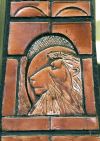GOSPEL READING

THE GOSPEL OF MARK
When?: Mk 13,24-37
We have seen that the second part of the speech begins with verse 24 with a strong "but". Notice how the first line picks up from verse 19.
As we saw in the overview, Jesus first gives an answer to the "when?" question, in 13,24-32, with the bracket of "those days" and "that day" in verses 24 and 32. The first part concerns the coming of the Son of Man, 13,24-27, while the second part is the lesson of the fig tree, 13,28-32. Verse 33 is then a conclusion with the final "look out" (as in 13,5,9 and 23).
13,34-37 is the final exhortation with "stay awake" as the theme, bringing the whole speech to a close. This exhortation is as we have noted unique to this Gospel.
The Day of the Lord: Mk 13,24-33
The coming of the Son of Man: 13,24-27
What follows in this speech of Jesus is based on quotations from the Old Testament, taken especially from the prophets.
Some passages to look at for verses 24-25: Isaiah 13,2-10; Joel 2,10-3,4; Amos 8,8-9.
For the coming of the Son of Man in verse 26 look at Daniel 7,13-14, as mentioned earlier. See also 8,38 and 14,62.
Finally, the idea of a remnant is also common in the OT, for example the prophet Isaiah (Is 11,11.16, 43,5-7) or Ezekiel 39,27-28 or Zechariah 10,6-11.
For the gathering of the elect in verse 27, see Dt 30,4 and Zech 2,6.
The lesson of the fig tree: 13,28-33
In verse 28, Jesus uses the fig tree as an image. The fig tree is one of the few trees in Palestine which is not an evergreen.
For verse 29, there is likely to be some variation in the translations. Which might fit our reading best?
This generation in verse 30 is mentioned also in 8,12.38 annd 9,19.
For the words of Jesus not passing away, see Is 40,8; 51,6.
Consider verse 32 in light of verse 30.
Verse 33 as we have seen is a final conclusion to "look out". "Watch" is then repeated with a verb which is used only here. The Greek word for "time" has echoes of 1,15.
Look now at the response.
Stay Awake! Mk 13,34-37
The speech ends with this final exhortation to watchfulness. Look at Mt 24,42.
The evangelist as we saw in the overview changes verb in this final conclusion. This we are translating "Stay awake!
Note that the new verb appears in verses 34,35 and 37. See also 14,34.37.38. The image given by Jesus is that of the doorkeeper. What sort of watchfulness is appropriate for a door keeper?
The exhortation in verses 35-36 is found elsewhere in the New Testament, 1 Thessalonians 5,4-6 for example.
To whom are the final words in verse 37 addressed?
We can now have a response.
The Sunday Gospels
33rd Sunday in Ordinary Time, year B: Mk 13,24-32
The Gospel read this Sunday is the passage which we have read as the first unit in the second part of the speech.
The OT reading chosen to accompany this Gospel is Daniel 12,1-3. We have seen these verses as part of the background to the speech. Why is this reading so important for Christians? How well does it accompany the Gospel?
1st Sunday of Advent, cycle B: Mk 13,33-37
How does Advent open with a different note to the last Sunday of Ordinary Time?
Now have another look at the response.
